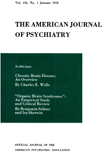TREATMENT OF PARKINSONISM
Abstract
Parkinsonism presents a notoriously discouraging therapeutic problem, since no treatment heretofore employed has significantly altered the course of the disease. Recent work with antihistamines suggests that certain of these compounds may have value in the Parkinsonian syndromes.
Promethazine chemically resembles chlorpromazine, which is known to be active upon the extrapyramidal system and related areas. It was decided to investigate the potential value of promethazine since it was believed that the compound might also affect the extrapyramidal structures but in a different way.
Twelve patients with advanced Parkinsonism (associated with cerebral arteriosclerosis in 5, of the postencephalitic type in 2, and of the idiopathic type in 5) received promethazine in conservative dosage by mouth for periods totaling 2 to 16 weeks.
Among the patients with Parkinsonism, 11 (91%) showed some evidence of improvement, which was not limited to motor activity alone but in most cases involved other physical and behavioral spheres in which there had been severe deterioration. One-third showed clinical change of an unusual degree.
Further study of promethazine in Parkinsonian syndromes and the associated mental disorders is suggested, especially for aged and arteriosclerotic patients.
Access content
To read the fulltext, please use one of the options below to sign in or purchase access.- Personal login
- Institutional Login
- Sign in via OpenAthens
- Register for access
-
Please login/register if you wish to pair your device and check access availability.
Not a subscriber?
PsychiatryOnline subscription options offer access to the DSM-5 library, books, journals, CME, and patient resources. This all-in-one virtual library provides psychiatrists and mental health professionals with key resources for diagnosis, treatment, research, and professional development.
Need more help? PsychiatryOnline Customer Service may be reached by emailing [email protected] or by calling 800-368-5777 (in the U.S.) or 703-907-7322 (outside the U.S.).



